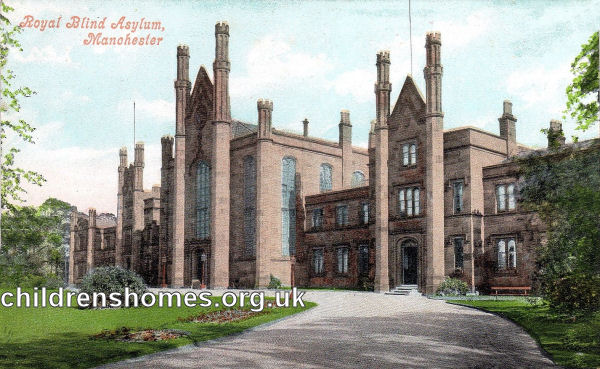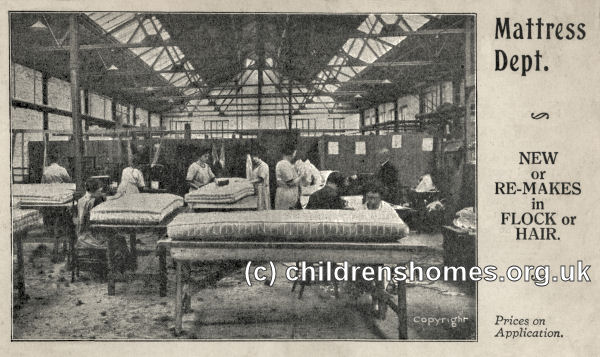Henshaw's Asylum/Institution for the Blind, Manchester, Lancashire
When Oldham hat manufacturer, Thomas Henshaw, died in 1810 he left the sum of £20,000 to establish an 'Asylum for the Indigent Blind'. The will was contested by his wife, Sarah, who claimed that it had been made while Henshaw was 'mentally unbalanced'. After 23 years of legal wrangling, the Court of Chancery finally gave a ruling endorsing the original will.
A site for the Asylum was found next the the Botanic Gardens on Chester Road, Old Trafford, where new premises for the Institution for the Deaf and Dumb were also planned to be erected. A joint scheme was developed in whichthe two new buildings would both be linked to a central chapel, to be used by both institutions. The two buildings, broadly similar in layout, and the chapel were all designed by Richard Lane and being 'semi-detached', allowed more of the funds to be allocated to the elegant frontage of the complex. The foundation stone for the scheme was laid on 23 March 1836, with the official opening taking place on 21 June 1837.
The School site is shown on the 1915 map below.

Henshaw's Institution for the Blind site, Manchester, c.1915.

Henshaw's Asylum for the Blind (at left), Manchester. © Peter Higginbotham
Henshaw's received both adults and children. The object of the establishment was stated as being 'To afford an asylum for the impotent and aged blind, and to maintain and afford such instruction to the indigent blind of both sexes capable of employment as will enable them to provide either wholly or in part for their own subsistence, and to promote the employment of, or to employ, blind persons.' Admission was by a periodic ballot of subscribers to the funds of the Asylum. Children were admitted from the age of nine years.
The premises originally housed 37 inmates but were gradually expanded, with a large new building being opened in 1887. In the same year, workshops were opened in Salford. However, these proved to be too small and expensive and were relocated to Deansgate in 1891. A large warehouse was subsequently purchased in Stretford, and a shop selling items made by the Asylum inmates was opened in Oxford Road. The Asylum also established an elementary school for blind children aged 5 to 16 and a technical college for students from 16 to 21 who were trained for occupations such as music or craftwork.
A 1914 article gives an interesting account of the development of the institution at that dates:
An idea of the value of the training thus imparted may gained from a remark by the Superintendent (Mr. W. H. Illingworth) to an "evening News" reporter this morning, after a tour of inspection the asylum. It was that practically every boy who has completed his training here in the course of the last five years and has then gone out the world is now self-supporting.
The boys, it should be said, are trained in music, basket work, mat-work, and boot repairing, and the girls in shorthand (by means of a specially-devised machine), typewriting, weaving, hand and machine knitting, light basket work, chair caning, and upholstery. The last-named industry is particularly favourable to the girls from a wage-earning point of view, and as a matter of fact there are blind women now employed upon it at the asylum earning as much as £1 a week, and in no case less than 12s.
On the opposite side of Chester Road the fine old mansion Throstle Nest has been acquired on lease for the purposes of the music school. Here blind youths who show the necessary aptitude are trained to become professional musicians — organists, pianists, or tuners. The house is capitally adapted to the purpose, and its equipment for the work done there leaves, one would imagine, nothing to be desired. The pupils are taught about the mechanism of their instruments and how to repair them, well as to play upon and to tune them, and great things are hoped from the development of this department of the asylum's work.
Further along the road and on the same side in the direction of Stretford is Oak Bank, the fine house and grounds given to the asylum by the late Mr. James Gresham. It is intended to erect new workshops at the rear of the house, which itself will probably be used for office purposes.
Another important branch of the asylum is the Mary Ann Scott Memorial Home and Workshops on the Hayesleigh estate, near Warwick Road, given by the late Mr. C. H. Scott, of this city, in memory of his wife. The idea in the first instance was to use the house and adjoining three acres of charming grounds as a school, but the establishment of the White City in the Botanical Gardens close by made this impracticable; and so the scheme now successfully in operation was decided upon. One part the institution is set apart as a home for the aged and infirm blind who are unable to work, and the other is given up for the training in various trades of those who have become blind after they have passed their youth. The trades taught are those already mentioned, and it is really astonishing how soon both men and women become proficient in them.
In this connection Mr. Illingworth called the reporter's attention to three men busily engaged brush-making. each of them, he said, was now earning from 20s. to 255. a week, and was living in his own home some distance from the asylum, and supporting his wife and family. Three years ago when these men entered the asylum, one a blacksmith, 58 years old, one a painter, 48 years old, and the other a compositor, years old, their cases would have appeared hopeless, and all this wonderful change had been wrought in the meantime. Some of the Industries. The customers for the asylum's brushes include the Lighting and Cleansing Committee of the Salford Corporation, the Irlam and Prestwich District Councils, the Withington Committee of the Manchester Corporation, the Manchester Ship Canal Company, and the Westinghouse works. well-paid industry for the blind is mat making, and inn particular motor mats, for which there is just now tremendous demand These are all made by asylum inmates. All sorts of basket work, too, is done there such, for instance, packing skips, doffing skips for mills, invalids' chairs, invalids' carriages, and flower baskets.
One of the occupations carried out at the Asylum was mattress making. A promotional card for the work is shown below.

Henshaw's Asylum for the Blind, Manchester, mattress making./p>
In 1921, the Asylum was renamed Henshaw's Institution for the Blind and by the 1930s was the largest establishment of its kind in the country.
In more recent times, Henshaw's has broadened its activities, with a service for the visually impaired as well as the blind beginning in 1971. At the same time, the Institution changed its name to Henshaw's Society for the Blind, and again in 2000 to Henshaw's Society for Blind People. Today, known simply as Henshaws, the charity provides a wide range of services for the blind and visually impaired across the Northern england and Wales.
Records
Note: many repositories impose a closure period of up to 100 years for records identifying individuals. Before travelling a long distance, always check that the records you want to consult will be available.
- Henshaws.
- Manchester University Library Special Collections, The John Rylands Library, 150 Deansgate, Manchester M3 3EH. Has financial accounts, committee minutes etc.
Census
Bibliography
- Higginbotham, Peter Children's Homes: A History of Institutional Care for Britain's Young (2017, Pen & Sword)
- Pritchard, D.G., Education and the Handicapped 1760-1960 (1963, Routledge & Kegan Paul)
- Wagg, Henry J A Chronological Survey of Work for the Blind (1932, Pitman)
Links
- Henshaws website.
Except where indicated, this page () © Peter Higginbotham. Contents may not be reproduced without permission.


